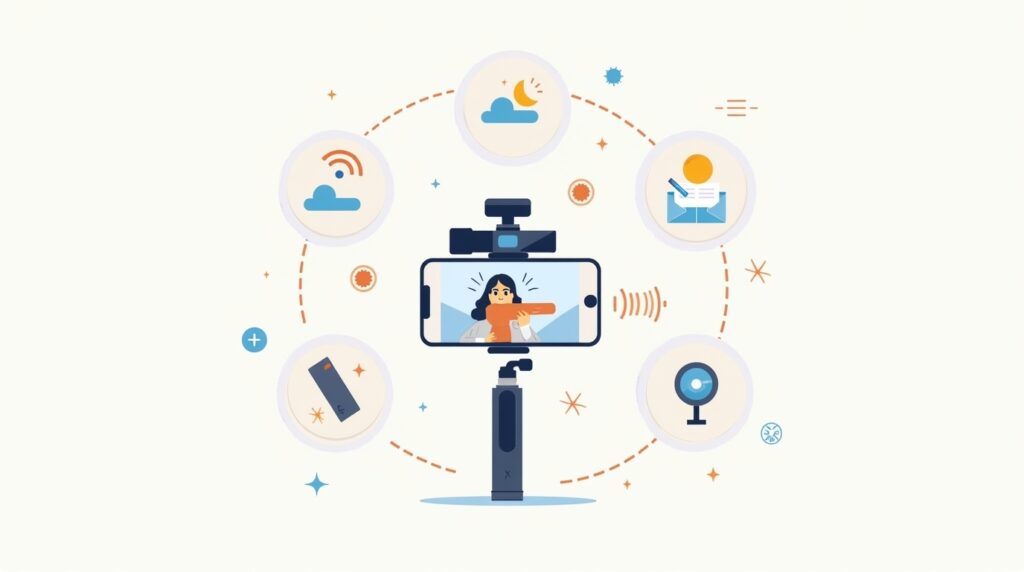✅ Introduction
When you’re streaming from unpredictable locations — city streets, festivals, or remote trails — a flexible, reliable setup makes all the difference. In this guide, we’ll show you how to optimize your mobile streaming setup for a variety of environments so you can deliver great content wherever you are, no matter the lighting, noise, or signal strength.
⚙️ What an Optimized Mobile Setup Looks Like
- 🎒 Portable and lightweight: Easy to carry, mount or pack.
- 🔋 Power-efficient: Extended battery life or hot-swappable packs.
- 📶 Stable connection: Adaptable to weak or fluctuating mobile signals.
- 🎙️ Clear audio capture: Even in loud or windy environments.
- 💡 Lighting-aware: Equipment that performs well in poor lighting.
🌙 Streaming in Low-Light or Night Environments
- 💡 Use low-light-friendly cameras like GoPro Hero 12 or Sony ZV-E10.
- 🔦 Bring a portable LED fill light with adjustable brightness (e.g., Lume Cube or Ulanzi).
- ⚙️ Enable auto ISO and exposure adjustments if your app or camera supports it.
- 🎨 Color-correct on the fly with filters in Prism Live Studio or Streamlabs Mobile.
💡 Pro Tip: Use soft lighting angled from the side to avoid harsh shadows and flat faces.
🏞️ Managing Connectivity in Remote or Crowded Areas
- 📶 Use dual SIM phones or mobile hotspots with multiple network options (e.g., Nighthawk M6, LiveU Solo).
- 📡 Switch to lower resolution (720p) or bitrate to maintain a smoother stream in bad conditions.
- 📱 Pretest your connection using Speedtest before going live — especially in new locations.
- 📂 Use apps that support bonding (like Larix Broadcaster) for multiple connection paths (cell + Wi-Fi).
💡 Pro Tip: Keep a short “stream starting soon” buffer scene loaded in case of connection drops.
🔊 Ensuring Clear Audio in Noisy or Windy Environments
- 🎙️ Use a wireless lav mic with a wind muff (e.g., Rode Wireless GO II with dead cat).
- 🎧 Monitor audio in real-time using a splitter and earbuds if your app supports monitoring.
- 🧩 Enable noise suppression or compression filters in-app (like Streamlabs Mobile).
- 💬 Practice mic placement — too far or too close can pick up wind or muffle voices.
💡 Pro Tip: Even a small foam windscreen can dramatically improve audio clarity on mobile.
📶If problems persist even after optimizing, our troubleshooting guide covers fixes for the most common IRL streaming headaches.
🎛️ Additional Setup Tips by Location Type
| Environment | Key Challenges | What to Adjust |
|---|---|---|
| Urban streets | Traffic, low light | Mic + LED light + stabilizer |
| Beaches/deserts | Wind, overheating | Wind muffs + sunshield for camera/phone |
| Events/festivals | Noise, crowd interference | Wireless lavs + privacy filters on overlays |
| Trails/hikes | Signal, bumps | Hotspot + gimbal + 720p stream settings |
❓ FAQ: Environmental Streaming Tips
A smartphone + gimbal + lav mic + power bank is a great minimalist combo.
Yes, but image quality improves drastically with a small LED light or night-mode camera.
Use phone rain covers, lens hoods, or ziplock bags for water protection in light rain.
🎬 Final Thoughts
A good stream doesn’t have to come from a perfect studio. By optimizing your mobile streaming setup for different environments, you’ll be prepared to deliver quality content from just about anywhere. A few key adjustments — like better lighting, cleaner audio, and smarter connection choices — go a long way toward keeping your stream smooth and your audience engaged.
